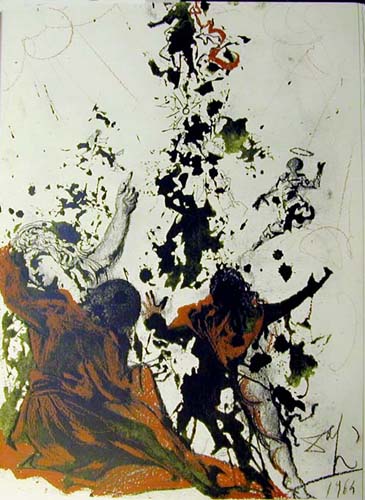Cat Goodrich
Faith Presbyterian Church, Baltimore, MD
February 14, 2021
Transformation
Mark 9:2-9
My mom was a high school English teacher, which means that she is a purveyor and teller of stories, and not one to hold back from offering advice. Having learned a thing or two about human nature from life and as an avid reader of fiction, she loved to advise me with stories – fables with morals that could not be missed. A favorite of hers goes like this:
A man was walking along a forest path, deep in the woods, and snow began to fall. Looking up at the grey sky through the trees and seeing the flakes begin to settle on the branches, he picked up his pace a bit, not wanting to get stuck out in the cold. As he hurried along the path, hopping over roots and rocks, he heard a voice call out “– excuse me, can you help me?”
Looking down, he saw a snake slithering beside the path. He jumped, because he noticed the snake’s sharply angled head and the pattern on his back and knew for sure that the snake was poisonous. Edging over to the other side of the path, the man said, “I’m sorry, did you just speak to me?”
The snake’s tongue darted out, tasting the air as he lifted his head and said, “why yes, I did. See, it’s cold and getting colder. I’ll freeze to death out here if I don’t get back to my den. But you’ve got that coat on with those big pockets. If you could just slip me in there and carry me a little ways down the path, you’ll save me and I’ll be forever grateful.”
The man hesitated, feeling torn. He didn’t want to be bitten by the snake, for then he would surely die. But he didn’t want to ignore the snake’s plea and leave the animal to die, either. As he weighed his options, the snake said, “Come on, please, just carry me a little ways.”
So the man gingerly picked him up, and slipped him headfirst into the pocket of his coat. They walked quickly down the trail towards the edge of the woods when the snake finally poked his head out of the man’s pocket and said, “Stop! Here! This is it – you saved me!”
And when the man, eager to be rid of the snake, stuck his hand in his pocket to pull him out, the snake bit him.
The man swore and tossed the snake to the ground, crying in anguish – “How could you do that? I helped you! Why did you bite me?”
The snake slithered toward a hole in the roots of a tree and shrugged his shoulders and hissed, “you knew I was a snake when you picked me up.”[1]
The moral of the story: When someone shows you who they are, believe them. Believe them.
It may not surprise you that the national news has reminded me of this story lately, especially coverage of the impeachment trial this past week. And I think my mom would tell it to me as a way of helping me navigate the twists and occasional disappointments of building friendships and relationships when I was young, learning who and how to trust.
This story comes to mind because this is both Transfiguration Sunday and Valentine’s Day, and I’m thinking about change, and trust, and love, and our capacity for all of them.
Today we remember the dramatic revelation of the divine Christ on a mountaintop. Until this point in Mark, Jesus has been making his way through Galilee, teaching and healing and challenging the death-dealing powers and practices that shut people out of communal life. This mountaintop encounter is a turning point. When Jesus and the disciples head back down the mountain, they turn toward Jerusalem and begin the descent into his final conflict with Rome and the religious leaders. Here at the edge of Lent, we, too, are turning toward Jerusalem, to make our own journey toward the agony of Gethsemane and the darkness of Calvary, the pain of Christ crucified and, eventually, the joy of the risen Christ.
But before that, here, on a mountaintop, God’s glory is revealed in Christ. Seeing this transformation, Peter, James, and John should have no doubt about who he is, and what he came to do. And yet, they seem to have a hard time believing it. I would, wouldn’t you? Can you imagine their utter shock and DISbelief? The text tells us they were terrified when they saw Christ change before their very eyes, from the man they knew into a glorious shining creature – no longer quite human –
heavenly to behold
terrifying to witness,
his robes dazzling white,
accompanied by Moses and Elijah – the law and the prophets, right there with him.
All three of them, shining brightly, radiant.
Scripture says that’s how it was with Moses, too, after forty days atop Mt Sinai, enveloped in a cloud of mystery, working out the details of the ten commandments with the one true God – he came down glowing. Had to wear a veil to shield his face after so much time in the presence of God. Radiance is one of the most common descriptors of what it’s like to see God – so bright, it’s like looking at the sun.
When have you seen someone and thought to describe them as radiant? People on their wedding day are often glowing with excitement and love. Expectant or new parents. Babies can be radiant, and so can happy children. An old woman’s smile. A person teaching about something they care deeply and passionately about, just shines, don’t they? Comes alive in a new way? Seems like love leads to radiance.
One of my first times out with Dary, I remember standing with him, waiting for the T at Charles Street in Boston. It was a bright spring day, on a raised platform, open air. There was an older woman there, waiting also, who was blind. For whatever reason, when the train came, she seemed hesitant to get on, and Dary went over and helped guide her onto the train. It was a small thing, really. But it stayed with me. When someone shows you who they are, believe them.
The word transfiguration itself means a complete change in form or appearance – Jesus the man, transformed into a shining deity. It’s not clear from the text how the change happens… if the Spirit brings this change upon Jesus, or if for some reason the disciples simple are able to see Christ’s true self for the first time. The message is clear: Christ is both human and holy, divine. But I don’t know if the disciples are able to comprehend what that means… if having been shown his true identity, they believe their friend is indeed the human manifestation of God. I wonder, once the vision goes away and the disciples head back down the mountain, what changes for them, having seen this. Has anything really changed at all?
Moments of transcendence, of radiance, are fleeting. When we experience them, how does it change us?
J Phillip Newell, a peripatetic prophet of the Iona Community, says that Christ came into the world to awaken our inner memory of God. We’re all made in the image and likeness of God, we just have to be able to recognize it: to see other people as the bearers of God’s love and light. And when we are able to see that, nothing really changes, but everything is different.
I always had a tough time accepting that story that my mother told, which I know she told from a place of love, wanting to protect me. But I want to think the best of people, to give others the benefit of the doubt, to resist painting someone with too broad a brush and writing someone off completely. If the resurrection teaches us anything, doesn’t it teach us that we are capable of change? I believe people change all the time. All the time, I hope we are getting better, wiser, more kind, more loving, more creative. Resilient. Maybe the transfiguration shows us that just as Christ changed outwardly, we disciples can be changed inwardly –when we see the world through his eyes, our hearts expand, helping us see all people worthy of love and belonging.
So, when someone shows you who they are, believe them – but also trust that God is still at work in them. We all have the capacity to change.
My hope is that our eyes will be opened this week, to see the radiant beauty of Christ in the people and world around us, that our hearts will be opened to love him, our hands opened to serve him. And that in so doing, we ourselves might be transformed.
[1] I learned in writing this that the fable can be either traced to or inspired a song written by activist Oscar Brown in 1963, and made famous by Al Wilson in 1968. And, I was horrified to learn that the story was also oft used to drum up anti-immigrant sentiment by a former President on the campaign trail.

